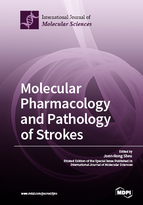Molecular Pharmacology and Pathology of Strokes
A special issue of International Journal of Molecular Sciences (ISSN 1422-0067). This special issue belongs to the section "Molecular Pathology, Diagnostics, and Therapeutics".
Deadline for manuscript submissions: closed (31 January 2019) | Viewed by 44937
Special Issue Editors
Interests: clinical and translational research; free radicals and oxidative stress; inflammation and microglia; neuroregeneration and neurodegeneration; novel drug development (bioactive and chemical synthesis) for treatment of stroke; pathological mechanisms; platelet activation and arterial thrombosis; hyperlipidemia and vascular diseases
Special Issues, Collections and Topics in MDPI journals
Interests: stroke; Alzheimer’s disease; gene therapy; neuroprotection; neurogenesis
Special Issues, Collections and Topics in MDPI journals
Special Issue Information
Dear Colleagues,
Stroke is an acute neurological event leading to neural tissue death in the brain, causing motor, sensory, and cognitive function loss. It is the second leading cause of death after coronary heart disease in developed countries. Despite the major advancements in cerebrovascular medicine over the past 50 years, stroke remains the number one public health concern and primary causes of death today. Breakthroughs in elucidating the basic molecular pharmacology in cerebrovascular function and thrombosis/coagulation, has led to significant advancements in the current treatment paradigm for patients with stroke. Innovation in these areas of research has led to remarkable discoveries and significantly reduced the mortality and morbidity from stroke. Nevertheless, more work and a tenacious pursuit of the basic/clinical sciences in cerebrovascular pathology and pharmacology are still wanted. The purpose of this Special Issue is to present knowledge of prevention and treatment by the use of novel drugs and nutraceuticals, with the help of our co-workers and globally-associated researchers. We encourage contribution by original research articles, as well as review articles, which will motivate the remaining efforts to understand the pathology underlying cerebrovascular diseases, and neurodegenerations, the development of strategies to prevent and treat these conditions, evaluation of outcomes, and epidemiological and clinical studies.
Prof. Dr. Joen-Rong Sheu
Prof. Dr. Howard Prentice
Guest Editors
Manuscript Submission Information
Manuscripts should be submitted online at www.mdpi.com by registering and logging in to this website. Once you are registered, click here to go to the submission form. Manuscripts can be submitted until the deadline. All submissions that pass pre-check are peer-reviewed. Accepted papers will be published continuously in the journal (as soon as accepted) and will be listed together on the special issue website. Research articles, review articles as well as short communications are invited. For planned papers, a title and short abstract (about 100 words) can be sent to the Editorial Office for announcement on this website.
Submitted manuscripts should not have been published previously, nor be under consideration for publication elsewhere (except conference proceedings papers). All manuscripts are thoroughly refereed through a single-blind peer-review process. A guide for authors and other relevant information for submission of manuscripts is available on the Instructions for Authors page. International Journal of Molecular Sciences is an international peer-reviewed open access semimonthly journal published by MDPI.
Please visit the Instructions for Authors page before submitting a manuscript. There is an Article Processing Charge (APC) for publication in this open access journal. For details about the APC please see here. Submitted papers should be well formatted and use good English. Authors may use MDPI's English editing service prior to publication or during author revisions.
Keywords
- platelet activation and thrombosis
- vascular diseases
- novel drug development
- neuroprotection
- pathogenic mechanisms
- free radicals/oxidative stress
- inflammation
- signal transductions
- clinical and translational research








